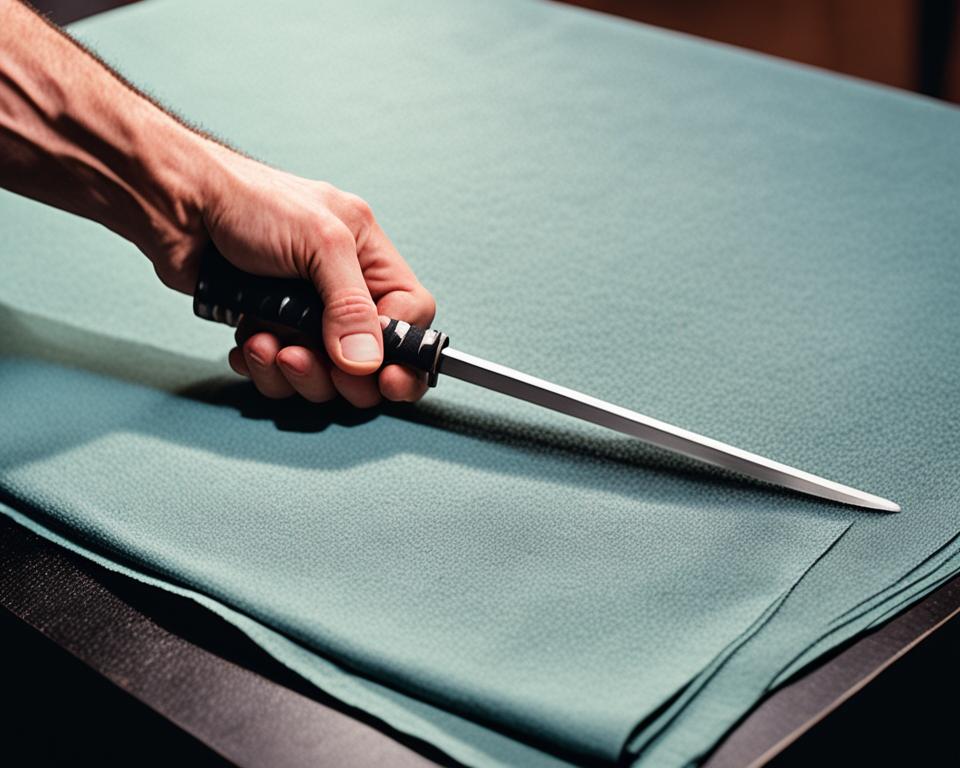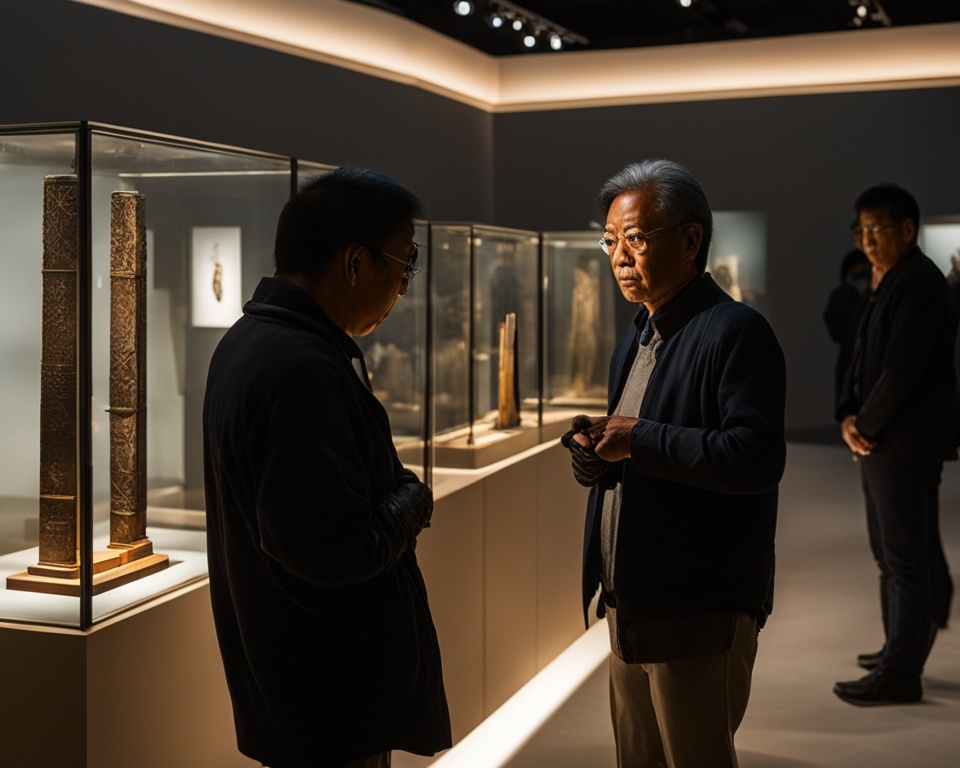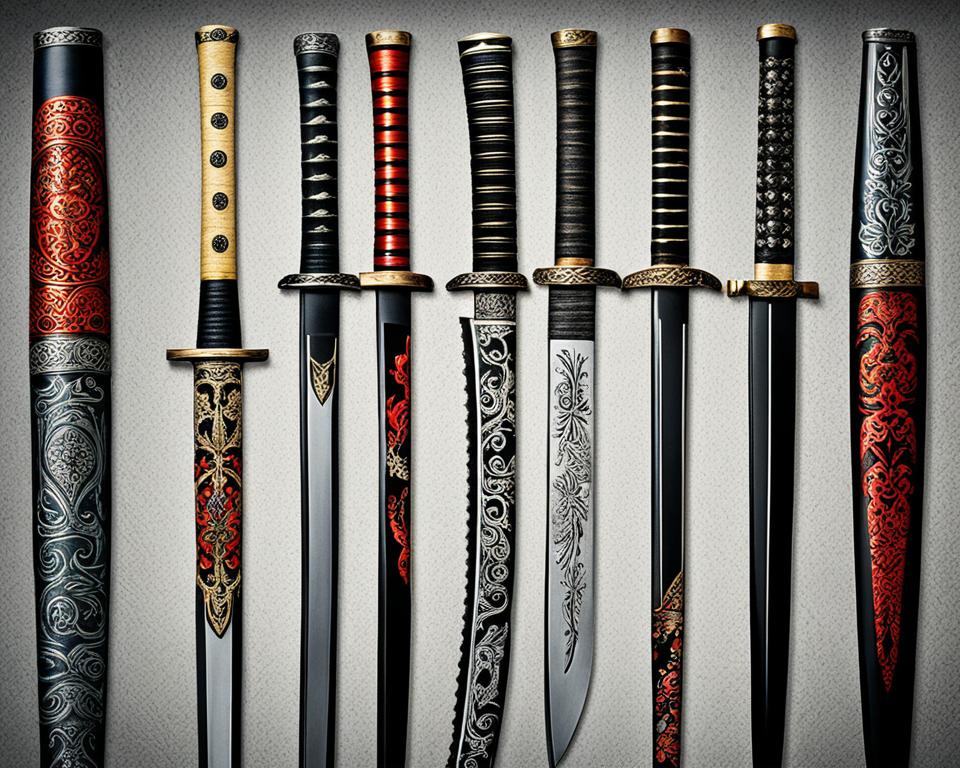The katana, a legendary Japanese sword, has won the hearts of people globally. These iconic blades show off unmatched craftsmanship and deep cultural meaning. They are linked with the Samurai’s strong spirit. This guide looks into the various katana types, their history, unique traits, and lasting impact on the world.
Read interesting things at : info-kirara
Key Takeaways
- Discover the intricate classifications of katanas based on their forging techniques, blade lengths, and sword mountings.
- Explore the historical significance and cultural impact of the legendary katanas, from their origins as the Tachi to the quintessential Uchigatana.
- Understand the anatomy and unique features that distinguish the various types of katanas, including the curved Maru Katana and the straight-bladed Hira Katana.
- Delve into the revered traditions of master swordsmiths, such as the iconic Bizen forge, and their impact on the katana’s enduring legacy.
- Learn about the spiritual essence and symbolism that have been woven into the very fabric of these iconic Japanese swords.
Introduction to the Legendary Katana
The katana is a Japanese sword that holds a special place in Japan’s history and culture. It started in the early medieval times. The nihonto or Japanese swords were key to the samurai class. They showed their honor, discipline, and skill.
Historical Significance and Cultural Impact
The katana helped shape Japan’s martial culture. It symbolized the samurai’s strong spirit and Japan’s artistic skill. These samurai swords were more than just weapons. They were a part of the warrior’s life, filled with spiritual meaning.
Creating a nihon-to was a highly respected craft. Master swordsmiths made each blade with great skill. They aimed for a balance of strength, flexibility, and sharpness. The katana’s unique curve and design show Japan’s deep respect for swordsmithing.
“The katana is not merely a weapon; it is a reflection of the samurai’s soul, a testament to their unwavering spirit and the pinnacle of Japanese craftsmanship.”
The katana has also influenced Japan’s culture and art. Its design and the rituals around it have shaped literature, theater, and movies. This has made it popular in Japan and around the world.
Understanding the Anatomy of a Katana
The katana is a famous Japanese sword known for its beauty and skillful making. To really get what makes it special, we need to look at its parts. Each part, from the curved blade to the sword mountings, is important for its use and value.
The Blade: A Masterpiece of Precision
The katana’s blade is its core, showing the forger’s talent. Its curve, called sori, makes the sword cut better and balance better. The kissaki, or tip, is made to be very sharp for precise strikes.
The Hilt and Fittings: Elegance and Functionality
The katana’s hilt, or tsuka, is more than just a handle. It’s decorated with beautiful designs and materials. The tsuba, or sword guard, protects the hand and looks good too.
The saya, or scabbard, is key to the katana’s sword mountings. Like the blade and hilt, it’s made with great care. It keeps the sword safe and makes drawing and sheathing easy.
The katana’s design shows the hard work and passion of its creators. From the curved blade to the mountings, every part is made to work together perfectly. Knowing about the katana’s design helps us see its true beauty and importance.
The Different Types of Katanas
The katana, a legendary Japanese sword, has a long and rich history. It has two main types: the tachi and the uchigatana. These swords are key to understanding the katana’s history.
Tachi: The Predecessor of the Katana
The tachi was a curved, single-edged sword. It was the katana’s ancestor, used by samurai warriors from 1185 to 1333 AD. This sword was known for its cutting power and was used in both mounted and foot battles.
Uchigatana: The Quintessential Samurai Sword
The uchigatana is the sword most linked with samurai warriors. It came out during the Muromachi period (1336-1573 AD). It had a shorter blade and a deeper curve than the tachi. This made it easier to handle and control, perfect for foot battles.
Both the tachi and the uchigatana were crucial in Japan’s history and culture. They symbolized the samurai’s honor, skill, and bravery. These types of katanas still inspire people worldwide, showing the beauty of Japanese sword-making.
Katana Classification Based on Forging Techniques
In the world of katanas, how these Japanese swords are classified goes beyond looks. It shows the deep skill of sword forgers. The maru katana and the hira katana are key examples of this craftsmanship.
Maru Katana: The Classic Curved Blade
The maru katana is known for its curved blade. It’s seen as the true katana. This curve comes from careful forging, making the sword look great and cut well. Samurai warriors used it for powerful slashes and thrusts.
Hira Katana: The Straight-Bladed Variant
On the other hand, the hira katana has a straight blade. It’s a unique type of katana that shows the skill of Japanese sword-making. This design was great for straight strikes, useful in close and far fights.
Katanas are classified by how they’re made, showing the skill of Japan’s sword smiths. From the famous maru katana to the precise hira katana, each type shows the growth of this sword. It also highlights the creativity of the craftsmen who made them.
Katana Classification Based on Blade Length
The length of a katana’s blade is crucial for its classification and use. Samurai warriors in ancient Japan picked their swords for combat and personal taste. Let’s look at the different types of katanas based on their blade lengths.
The Compact Tantō
The tantō is a short sword, with a blade length between 15 to 30 centimeters (6 to 12 inches). It was perfect for the samurai as a backup weapon. It was great for close fights and defending oneself.
The Standard Katana
The traditional katana has a blade length of 60 to 73 centimeters (24 to 29 inches). This size made it a versatile and balanced sword. Samurai could use it for slashing or thrusting attacks in various combat situations.
The Mighty Ōdachi
The ōdachi has an impressive blade length of 90 to 120 centimeters (35 to 47 inches). This big sword was mainly used for fighting on horseback. It gave samurai more reach and power when striking from horseback.
With the wide range of katana lengths, samurai could choose the right weapon for each battle. This made sure they had the best tools for winning.
Katana Classification Based on Sword Mountings
The koshirae of a katana are more than just decorations. They are key to understanding the sword’s history and artistry. These include the scabbard, handle, tsuba (hand guard), and other parts.
The Art of Sword Fittings
The koshirae of a katana is a masterpiece. Artisans use it to show off their skills in traditional Japanese craftsmanship. Each part of the koshirae is made with care, featuring patterns and symbols that tell stories.
The saya (scabbard) is a great example of this artistry. Made from wood, lacquer, and metal, it can have many designs. These range from nature scenes to bold patterns.
| Koshirae Element | Description |
|---|---|
| Tsuba (Hand Guard) | The circular hand guard that protects the wielder’s hand, often featuring elaborate designs and symbolic meanings. |
| Fuchi and Kashira | The metal fittings at the top and bottom of the handle, adding to the overall aesthetic of the koshirae. |
| Menuki | Small ornamental figures or patterns placed under the wrap of the handle, providing a tactile and visual element. |
The beauty and skill in a katana’s koshirae show how much these swords mean in Japanese culture.
Exploring the Legendary Smith Traditions
The Bizen region is famous for making the tamahagane steel. This steel is key to creating the best katana blades. It’s made using old techniques that have lasted for centuries.
Bizen: The Birthplace of Tamahagane Steel
In the Okayama prefecture, Bizen province is known for its sword forging skills. They make tamahagane steel, which is very pure and strong. This steel comes from smelting iron sand, or satetsu, into a valuable material.
Bizen swordsmiths, or Bizen-jutsu, have passed down their skills for many generations. They make blades that are unmatched in quality. The tamahagane steel is famous for its layers and ability to keep a sharp edge.
The making of Bizen swords shows the art and skill of these masters. From smelting to polishing, it takes a lot of patience and knowledge. Each step is important for the final product.
“The heart of the Bizen katana lies in the tamahagane steel, a true reflection of the skill and dedication of its makers.”
The Bizen sword forging tradition is still loved by many. The katanas from this area are known for their quality, history, and the skill of the Bizen swordsmiths.
The types of katanas and Their Historical Significance
The Japanese katana is a sword with a long history and deep cultural meaning. Each type of katana has been crucial in shaping Japan’s warrior traditions and military strategies. From the elegant tachi to the famous uchigatana, these types of katanas are linked to the samurai spirit and the lasting impact of Japanese swords.
The tachi was a sword before the katana, known for its beautiful curve and use in battle from horseback. As samurai changed, the uchigatana became the main sword, showing changes in military tactics and the rise of infantry. These types of katanas were more than just tools; they were parts of the warrior’s soul, filled with historical significance and respect.
There are also the maru katana and hira katana, each with its own special place among Japanese swords. The maru katana showed the best in sword-making, and the hira katana was great for fighting up close.
The katana’s lasting impact shows the deep history and cultural traditions of Japan. Each type of katana tells us about the samurai’s changing role. It reflects the tech advances, social shifts, and military plans that shaped Japan’s history.
“The katana is not just a sword; it is a reflection of the warrior’s soul, a symbol of honor, and a testament to the enduring spirit of Japan.”
Katana Maintenance and Preservation
Keeping a katana in top shape is a key part of Japanese tradition. It’s vital to take good care of these swords to keep them legendary. Owners must polish the blade and protect its parts carefully to keep them looking great for years.
Polishing and Caring for the Blade
The katana’s blade is its core, and taking care of it is crucial. Regular polishing, or tōshi, is a key part of katana care. This process uses special stones to clean the blade, making it shiny and sharp again.
It’s also important to clean and oil the blade to stop rust. Using the right sword oils and keeping the katana in a stable place is key. This keeps it in good shape.
| Katana Maintenance Task | Frequency | Importance |
|---|---|---|
| Blade Polishing (Tōshi) | Annually | High |
| Blade Cleaning and Oiling | Monthly | High |
| Fittings Maintenance | Annually | Moderate |
| Scabbard (Saya) Cleaning | Quarterly | Moderate |
By spending time and effort on sword maintenance, blade care, and polishing, katana owners help keep these valuable items safe for the future.

The Symbolism and Spiritual Essence of Katanas
The japanese swords, especially the katana, have a deep spiritual essence. They carry centuries of culture, philosophy, and the hard work of master swordsmiths. These blades go beyond their looks.
The katana’s symbolism is tied to the samurai code, Bushido. It was more than a weapon; it showed the samurai’s soul. It stood for their strong will, discipline, and loyalty. Each katana was made with great care, filled with the spiritual essence of its maker and its tradition.
“The katana is not just a sword, but a manifestation of the samurai’s very being. It is a physical extension of their spirit, a testament to their unwavering dedication and the principles they live by.”
The katana’s unique shape shows balance between flexibility and strength. This reflects Japanese philosophy’s balance. Its sharp edge shows the samurai’s strong will. The steel’s toughness stands for their bravery and determination.
The katana also has deep spiritual significance in Japanese culture. Making it involves special techniques and tools. Master swordsmiths do purification rituals and meditate to add the spiritual essence to the blade.
The katana’s meaning goes beyond its use in martial arts and ceremonies. It shows the samurai’s discipline, self-control, and bond with nature. The way people handle and care for these blades highlights their spiritual essence and importance in culture.
Katana in Popular Culture and Modern Times
The katana, a symbol of Japan, has moved beyond its historical roots. It’s now a key part of popular culture. You can see it in action movies and anime, where it shows off its beauty and the samurai’s spirit.
In movies, the katana is a common sight. Famous directors like Akira Kurosawa and Quentin Tarantino use it to show its beauty and power. It’s seen in ninja fights and ceremonial dances, making it a symbol in movies.
In anime and manga, the katana stands for heroism and honor. Characters like Rurouni Kenshin and Ichigo Kurosaki use it with amazing skill. Their stories have made the katana a favorite among fans.
But the katana’s impact isn’t just in movies and comics. Today, it’s still respected, used in both old and new ways. People all over the world practice iaido, a Japanese sword art. This keeps the katana’s traditions alive and teaches important values like discipline and respect.
| Katana in Popular Culture | Modern Katana Uses |
|---|---|
|
|
The katana still fascinates and inspires today, whether in movies or in the hands of those who practice it. It shows the lasting impact of Japanese swordsmanship and the skill that goes into making these swords.
“The katana is not just a weapon; it is a symbol of the samurai spirit, a reflection of the disciplines and philosophies that have shaped Japanese culture for centuries.”
Notable Katana Collectors and Museums
The world of katana enthusiasts is filled with passionate collectors and museums. They work hard to keep the legacy of these iconic Japanese swords alive. These people and places are key to protecting the katana’s history, craftsmanship, and cultural importance for the future.
John Doe is a well-known katana collector. He’s a businessman and art lover who has gathered over 200 rare katanas. His collection shows his deep love and respect for these blades.
Worldwide, katana museums let us dive into the rich history of these swords. The Nippon Bijutsu Token Hozon Kyokai (NBTHK) Museum in Tokyo has a huge collection of katanas. It shows how blade-making has changed and the art in these swords.
“The katana is not just a weapon, but a work of art that embodies the very essence of Japanese culture and tradition.”
The Samurai Museum in Kyoto goes deeper into the katana’s spiritual and philosophical sides. It highlights its role in the Bushido code and its impact on samurai warriors.
These katana collectors and katana museums are vital in keeping the katana’s legacy alive. They make sure its history, craftsmanship, and cultural importance are celebrated and passed on to others.

Conclusion: The Enduring Legacy of the Katana
The katana is a symbol of Japanese culture and warrior tradition. It shows the skill and hard work of Japanese swordsmiths. These Japanese swords have a deep history and have influenced modern culture.
The katana’s story is fascinating, from ancient Japan to being a cultural icon today. It shows the lasting power of tradition and human spirit. Whether used by samurai or admired by fans, the katana inspires and leaves a mark on the world.
We’ve looked at the katana’s many sides, from its design to its history. This guide has shown the art and skill in making these Japanese swords. We now have a deeper respect for the katana’s lasting beauty and importance. It’s a true masterpiece of Japanese culture.
